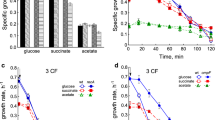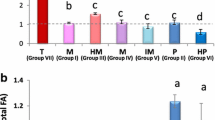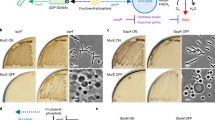Abstract
Decanoate exerted a stronger bactericidal action onEscherichia coli K76 (β-oxidation negative) than on its β-oxidation constitutive parent,E. coli K113; both strains had a normal lipopolysaccharide layer.E. coli RC59, a mutant carrying a defective lipopolysaccharide layer, was more sensitive than its parent,E. coli O111B4, to the growth inhibition by decanoate. Oleate did not affectE. coli RC59 viability, but washing of the cells rendered them sensitive.E. coli RC59 was unable to degrade decanoate and oleate. A mutant of this strain was isolated (E. coli ER20) which retained the defective lipopolysaccharide but was able to metabolize oleic acid. When the killing effect of oleate was assayed on washed cells ofE. coli O111B4, RC59, and ER20, a positive correlation between β-oxidation activity and the number of surviving viable cells was found. The ability of Gram-negative organisms to withstand the toxic effect of fatty acids was attributed to the presence of a lipolysaccharide (LPS) layer in the cell envelope. An additional mechanism of resistance is suggested by the results in this report which show that the ability to oxidize fatty acids contributes to resistance.
Similar content being viewed by others
Literature Cited
Ames, G. P., Spudich, E. N., Nikaido, H. 1974. Protein composition of the outer membrane ofSalmonella typhimurium: Effect of lipolysaccharide mutations. Journal of Bacteriology117:406–416.
Eisler, D. M., Von Metz, E. K. 1968. Anti-Pasteurella pestis factor. III. Effects of fatty acids onPasteurella pestis. Journal of Bacteriology95:1767–1773.
Farías, R. N., Trucco, R. E. 1972. Mutants ofEscherichia coli able to grow on short-chain fatty acids. Isolation and characterization. Revista Latinoamerica de Microbiología14:11–13.
Fay, J. P., Farías, R. N. 1975. The inhibitory action of fatty acids on the growth ofEscherichia coli. Journal of General Microbiology91:233–240.
Fay, J. P., Farías, R. N. 1976. Chilling cells enhances the bactericidal action of fatty acid onEscherichia coli. Applied and Environmental Microbiology31:153–157.
Fay, J. P., Farías, R. N. 1977. Inhibitory action of a non-metabolizable fatty acid on the growth ofEscherichia coli: Role of metabolism and outer membrane integrity. Journal of Bacteriology132:790–795.
Freese, E. C., Sheu, C. W., Galliers, E. 1973. Functions of lipophilic acids as antimicrobial food additives. Nature241:321–325.
Kabara, J. J., Swieczkowski, D. M., Conley, A. J., Truant, J. P. 1972. Fatty acids and derivatives as antimicrobial agents. Antimicrobial Agents and Chemotherapy4:501–506.
Klein, K., Steinberg, R., Fiethen, B., Overath, P. 1971. Fatty acid degradation inEscherichia coli. An inducible system for the uptake of fatty acids and further characterization of old mutants. European Journal of Biochemistry19:442–450.
Koplow, J., Goldfine, H. 1974. Alterations in outer membrane of the cell envelope of heptose-deficient mutants ofEscherichia coli. Journal of Bacteriology117:527–543.
Mangiarotti, G., Apirion, D., Schlessinger, D. 1966. Selection of sucrose-dependentEscherichia coli to obtain envelope mutants and fragile cultures. Science153:892–894.
Overath, P., Pauli G., Schairer, H. U. 1969. Fatty acid degradation inEscherichia coli. An inducible acyl-CoA synthetase, the mapping of old mutations and the isolation of regulatory mutants. European Journal of Biochemistry7:559–574.
Overath, P., Raufuss, E. M. 1967. The inhibition of the enzymes of fatty acid degradation inEscherichia coli. Biochemical and Biophysical Research Communications29:28–33.
Salanitro, J. P., Wegener, W. S. 1971. Growth ofEscherichia coli on short-chain fatty acids. Growth characteristics of mutants. Journal of Bacteriology108:885–892.
Sheu, C. W., Freese, E. 1972. Effects of fatty acids on growth and envelope proteins ofBacillus subtilis. Journal of Bacteriology111:516–524.
Sheu, C. W., Freese, E. 1973. Lipopolysaccharide layer protection of Gram-negative bacteria against inhibition by long-chain fatty acids. Journal of Bacteriology115:869–875.
Singh, A. P., Bragg, P. D. 1974. Effect of dicyclohexylcarbodiimide on growth and membrane-mediated processes in wild-type and heptose-deficient mutants ofEscherichia coli. Journal of Bacteriology119:129–137.
Weeks, G., Shapiro, M., Burns, R. O., Wakil, S. J. 1969. Control of fatty acid metabolism. I. Induction of the enzymes of fatty acid oxidation inEscherichia coli. Journal of Bacteriology97:827–836.
Wolin, M. J. 1969. Volatile fatty acids and the inhibition ofEscherichia coli growth by rumen fluid. Applied Microbiology17:83–87.
Wu, N. C. 1972. Isolation and characterization of anEscherichia coli mutant with alteration in the outer membrane proteins of the cell envelope. Biochimica et Biophysica Acta290:274–289.
Author information
Authors and Affiliations
Rights and permissions
About this article
Cite this article
Fay, J.P., Farías, R.N. β-Oxidation-mediated resistance ofEscherichia coli to inhibition by long-chain fatty acids. Current Microbiology 5, 147–152 (1981). https://doi.org/10.1007/BF01578519
Issue Date:
DOI: https://doi.org/10.1007/BF01578519




